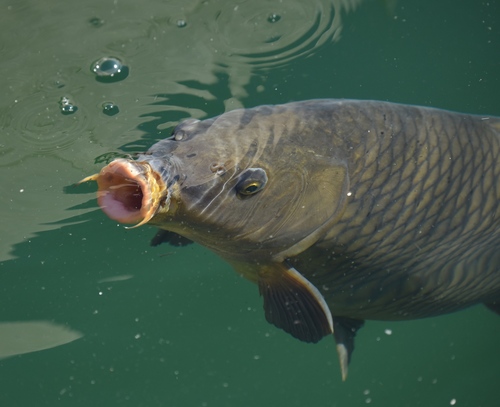
Common Carp
The Bluefin Tuna, belonging to the genus Thunnus, are among the largest, fastest, and most commercially valuable fish in the ocean. Renowned for their incredible migrations and powerful swimming abilities, they are apex predators playing a crucial role in marine ecosystems. This article explores their unique characteristics and the challenges they face.
9 47 years
Lifespan
120 cm
Length
Vulnerable
Conservation Status
8 km/h
Swimming speed
Omnivorous, Detritivorous
Diet
Local Migration
Migration
Appearance Overview
The Bluefin Tuna is renowned for its large, streamlined body, built for speed and endurance in the open ocean.
Color
Dark metallic blue on top with a silvery underside
Body Shape
Torpedo-shaped, facilitating high-speed swimming
Fins
Two dorsal fins, with the second being taller than the first; small, yellow finlets running from the second dorsal and anal fins to the tail
Length
Up to 10 feet (3 meters), though some individuals can reach up to 14 feet
Weight
Typically up to 1,500 lbs (680 kg), but can reach over 2,000 lbs
Diet
Carnivorous, feeding on a variety of fish, squid, eels, and crustaceans. They are opportunistic predators.
Feeding Behavior
Uses speed to chase down prey, sometimes in coordinated schools. They are known for their aggressive feeding style.
Social Behavior
Highly migratory, forming large schools, especially during spawning. They exhibit complex social behaviors, including cooperative hunting.
Commercial Relevance
Extremely high value, particularly in sushi and sashimi markets, where it is considered a delicacy. This demand drives high prices.
Conservation measures
International fishing quotas, seasonal fishing closures, minimum size limits, and marine protected areas. Efforts are also underway to improve fishing gear selectivity.
Status
Varies by species: Atlantic Bluefin Tuna is Endangered, Pacific Bluefin Tuna is Vulnerable, and Southern Bluefin Tuna is Critically Endangered.
Threats
Overfishing (driven by high demand for sushi), bycatch in other fisheries, climate change affecting prey distribution, and habitat degradation.
Habitat Distribution
Depth Range
0-900 meters, though they are most commonly found in the upper few hundred meters of the water column.
Geographic Range
Atlantic Ocean (from Newfoundland to the Mediterranean Sea), Pacific Ocean (from Japan to California), and Southern Ocean (around Australia and New Zealand).
Preferred Environment
Temperate and subtropical waters, open ocean (pelagic), often associated with underwater features like seamounts.
Reproduction and Life Cycle
Breeding Habits
Spawns in warm waters, with major spawning grounds in the Gulf of Mexico and the Mediterranean Sea. Spawning typically occurs during specific seasons.
Development Stages
Larvae hatch in plankton-rich waters and grow rapidly, transitioning through juvenile stages before reaching adulthood. Growth rates are influenced by water temperature and food availability.
Fecundity
Females can produce millions of eggs per season, releasing them into the water column for external fertilization.
Maturity Age
Matures at 4-8 years for Atlantic Bluefin, 3-5 years for Pacific Bluefin, and 8-12 years for Southern Bluefin.
Faqs about Common Carp
Where are Bluefin Tuna found?
Bluefin Tuna are found in the Atlantic, Pacific, and Indian Oceans, as well as the Mediterranean Sea.
Are Bluefin Tuna warm-blooded?
Yes, Bluefin Tuna are warm-blooded, allowing them to maintain a higher body temperature than the surrounding water.
How long do Bluefin Tuna live?
Bluefin Tuna can live up to 40 years, though the average lifespan varies depending on the species and environmental factors.
How fast can Bluefin Tuna swim?
Bluefin tuna can swim at burst speeds of up to 43 mph (70 km/h).
Do bluefin tuna migrate?
Yes, they are highly migratory fish, traveling thousands of miles across oceans for feeding and spawning.
Copyright @ Nature Style Limited. All Rights Reserved.
 English
English